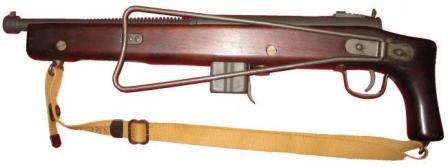
Early production ReisingM50 submachine gun, so called "commercial" or "police" model, with20-round magazine.

Late production ReisingM50 submachine gun, "military" model.

ReisingM55 submachine gun, with shoulder stock folded.

Reising M60semiautomatic carbine.
Characteristics
| Reising M50 | Reising M55 | |
| Caliber | .45 ACP | |
| Weight | 3,06 kg empty | 2,81 kg empty |
| Length (stock closed/open) | 857 mm | 556 / 781 mm |
| Barrel length | 279 mm | 263 mm |
| Rate offire | 550 roundsper minute | 500rounds per minute |
| Magazinecapacity | 12 or 20 rounds | 12 or 20 rounds |
| Effective range | 100 meters | 100 meters |
The Reising submachine gun was designed by American Eugene Reising and patented in 1940. Production of the new submachine gun commenced in 1941 at Harrington & Richardson (H&R) arms factory. In 1942, US Marine Corps signed first contract for delivery of Reising M50 submachine guns, and several tents of thousands of Reising M50 SMG's were delivered to USMC during the war. It must be noted that USMC weapons were slightly different in appearance from original version, having different trigger guard, larger takedown screw head, and other minor changes. Similar weapons were sold to various US agencies to guard military facilities and other important locations in USA. For USMC paratroopers and tankers H&R produced a folding-stock version, known as Reising M55. H&R also produced a semi-automatic only version of the M50, known as M60, which was used for training and guard purposes. The least known version is the Reising M65, a training semi-automatic weapon chambered for .22LR ammunition. It must be noted that US Marines generally disliked the Reising gun for its poor reliability, especially when gun was fouled or dirty. However, it was quite accurate and sufficiently reliable in "urban" conditions, so many Reising submachine guns were used by various US Police departments through several post-war decades.
Reising M50 submachine gun is delayed blowback operated, selective fired weapon. It fired from closed bolt and has a separate striker (non-pivoting, sliding hammer) which hit the firing pin when gun was discharged. The delay for opening movement of the bolt was provided by displacing its rear upper edge from the recesses, made on the inside of the receiver. The fire mode selector was located at the right side of the receiver, in front of the rear sight. Charging handle was unusually located in the slot, formed on the underside of the stock, in front of the magazine. To cock the gun, shooter must insert his finger into the slot and pull the cocking handle back, and then release it. Feed was from box magazines; standard magazine capacity was 20 rounds, with cartridges held in double stack and with single position feed. For training purposes, H&R also produced 12-round single stack magazines. Currently, aftermarket 30-round magazines are available for all .45 caliber Reising weapons. Sights included front post and a diopter rear, adjustable from 50 to 300 yards range. Original M50 submachine guns featured an one-piece wooden stock and a muzzle flip compensator. "Paratrooper" Reising M55 guns had wooden stocks with pistol grip and side-folding stocks made from steel wire, and no muzzle compensators. Both types of submachine gun featured partially finned barrels. Semi-automatic only Resing M60 carbines featured longer barrels with no fins.